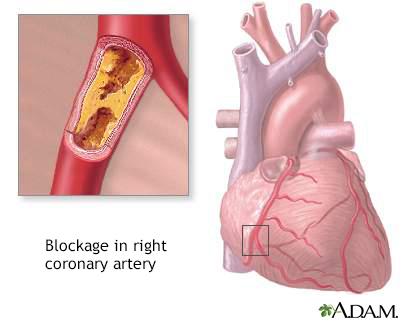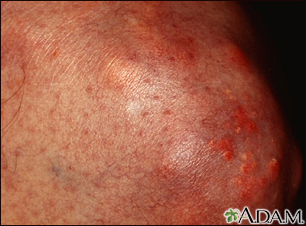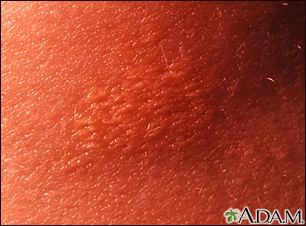Familial hypercholesterolemia
Definition
Familial hypercholesterolemia is a disorder that is passed down through families. It causes LDL (bad) cholesterol level to be very high. The condition begins at birth and can cause heart attacks at an early age.
Related topics include:
Alternative Names
Type II hyperlipoproteinemia; Hypercholesterolemic xanthomatosis; Low density lipoprotein receptor mutation
Causes
Familial hypercholesterolemia is a genetic disorder. It is caused by a defect on chromosome 19.
The defect makes the body unable to remove low density lipoprotein (LDL, or bad) cholesterol from the blood. This results in a high level of LDL in the blood. This makes you more likely to have narrowing of the arteries from atherosclerosis at an early age. The condition is typically passed down through families in an autosomal dominant manner. That means you only need to get the abnormal gene from one parent in order to inherit the disease.

In rare cases, a child may inherit the gene from both parents. When this occurs, the increase in cholesterol level is much more severe. The risk for heart attacks and heart disease are high, even in childhood.
Symptoms
In the early years there may be no symptoms.
Symptoms that may occur include:
- Fatty skin deposits called xanthomas over parts of the hands, elbows, knees, ankles and around the cornea of the eye
- Cholesterol deposits in the eyelids (xanthelasmas)
- Chest pain (angina) or other signs of coronary artery disease may be present at a young age
- Cramping of one or both calves when walking
- Sores on the toes that do not heal
- Sudden stroke-like symptoms such as trouble speaking, drooping on one side of the face, weakness of an arm or leg, and loss of balance

Exams and Tests
A physical exam may show fatty skin growths called xanthomas and cholesterol deposits in the eye (corneal arcus).
The health care provider will ask questions about your personal and family medical history. There may be:
- A strong family history of familial hypercholesterolemia or early heart attacks
- High level of LDL cholesterol in either or both parents
People from families with a strong history of early heart attacks should have blood tests done to determine lipid levels.
Patient Education Video: Understanding cholesterol results
Blood tests may show:
- High level of total cholesterol
- High LDL level
- Normal triglyceride levels
Other tests that may be done include:
- Studies of cells called fibroblasts to see how the body absorbs LDL cholesterol
- Genetic test for the defect associated with this condition
Treatment
The goal of treatment is to reduce the risk of atherosclerotic heart disease. People who get only one copy of the defective gene from their parents may do well with diet changes and statin drugs.
LIFESTYLE CHANGES
The first step is to change what you eat. Most of the time, the provider will recommend that you try this for several months before prescribing medicines. Diet changes include lowering the amount of fat you eat so that it is less than 30% of your total calories. If you are overweight, losing weight is very helpful.
Here are some ways to cut saturated fat out of your diet:
- Eat less beef, chicken, pork, and lamb
- Replace full-fat dairy products with low-fat products
- Eliminate trans fats
You can lower the amount of cholesterol you eat by eliminating egg yolks and organ meats such as liver.
It may help to talk to a dietitian who can give you advice about changing your eating habits. Weight loss and regular exercise may also help lower your cholesterol level.
MEDICINES
If lifestyle changes do not change your cholesterol level, your provider may recommend that you take medicines. There are several types of drugs available to help lower blood cholesterol level, and they work in different ways. Some are better at lowering LDL cholesterol, some are good at lowering triglycerides, while others help raise HDL cholesterol. Many people will be on several medicines.
Statin drugs are commonly used and are very effective. These drugs help lower your risk of heart attack and stroke.
They include:
- Lovastatin (Mevacor)
- Pravastatin (Pravachol)
- Simvastatin (Zocor)
- Fluvastatin (Lescol)
- Atorvastatin (Lipitor)
- Pitivastatin (Livalo)
- Rosuvastatin (Crestor)
Other cholesterol-lowering medicines include:
- Bile acid-sequestering resins.
- Ezetimibe.
- Fibrates (such as gemfibrozil or fenofibrate).
- Nicotinic acid.
- PCSK9 inhibitors, such as alirocumab (Praluent) and evolocumab (Repatha). These represent a newer class of drugs to treat high cholesterol.
People with a severe form of the disorder may need a treatment called apheresis. Blood or plasma is removed from the body. Special filters remove the extra LDL cholesterol, and the blood plasma is then returned to the body.
Outlook (Prognosis)
How well you do depends on how closely you follow your provider's treatment advice and how well you respond to the recommended treatment. Making diet changes, exercising, and taking your medicines correctly can lower cholesterol level. These changes can help delay a heart attack, especially for people with a milder form of the disorder.
Men and women with familial hypercholesterolemia typically are at increased risk of early heart attacks.
Risk of death varies among people with familial hypercholesterolemia. If you inherit two copies of the defective gene, you have a poorer outcome. That type of familial hypercholesterolemia does not respond well to treatment and may cause an early heart attack.
Possible Complications
Complications may include:
- Heart attack at an early age
- Heart disease
- Stroke
- Peripheral vascular disease
When to Contact a Medical Professional
Seek medical care right away if you have chest pain or other warning signs of a heart attack.
Contact your provider if you have a personal or family history of high cholesterol level.
Prevention
A diet low in cholesterol and saturated fat and rich in unsaturated fat may help to control your LDL level.
People with a family history of this condition, particularly if both parents carry the defective gene, may want to seek genetic counseling.
Gallery



References
Genest J, Mora S, Libby P. Lipoprotein disorders and cardiovascular disease. In: Libby P, Bonow RO, Mann DL, Tomaselli GF, Bhatt DL, Solomon SD, eds. Braunwald's Heart Disease: A Textbook of Cardiovascular Medicine. 12th ed. Philadelphia, PA: Elsevier; 2022:chap 27.
Robinson JG. Disorders of lipid metabolism. In: Goldman L, Schafer AI, eds. Goldman-Cecil Medicine. 26th ed. Philadelphia, PA: Elsevier; 2020:chap 195.
